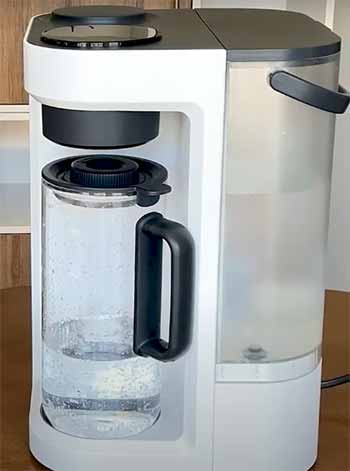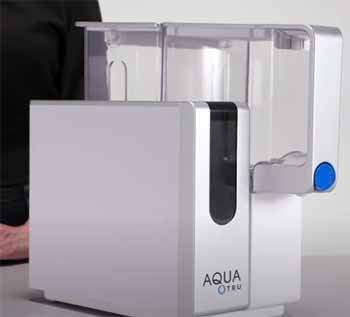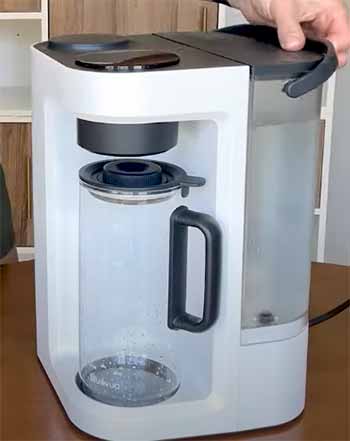I’ve always been a bit obsessed with clean water. Maybe it’s because I grew up in a place where the tap water tasted like a rusty coin, or maybe it’s just my inner skeptic kicking in about what’s really flowing through those pipes.
So, when I started shopping for a countertop water filter, I narrowed it down to two big names: Bluevua and AquaTru.
My goal?
To figure out which one’s the real deal for me—and for you. In this article, I’m breaking down my experience with both, weighing the pros and cons, and helping you decide which filter fits your life. Let’s get into it.
A Brief Comparison Table
| Feature | Bluevua RO100ROPOT | AquaTru Classic |
| Filtration Stages | 4 (optional UV, remineralization) | 4 (reverse osmosis) |
| Contaminant Removal | 99%+ (third-party tested) | 83+ (NSF-certified) |
| Filter Lifespan | 12-24 months | 6-24 months |
| Water Waste Ratio | 2:1 | 4:1 |
| Installation | Plug-and-play | Plug-and-play |
| Capacity | 0.5 gallons | 0.75 gallons |
| Smart Features | LED display, TDS monitoring | Optional Wi-Fi (Connect model) |
| Price (Approx.) | $300-$400 | $400-$500 |
| Warranty | 1 year | 1 year (extendable for fee) |
| Material | Glass carafe | BPA-free plastic |
What’s Bluevua All About?

First up, Bluevua. I got my hands on the RO100ROPOT model, and right out of the box, it caught my eye.
The glass carafe screamed “premium” compared to the plastic pitchers I’d used before.
Setting it up was a breeze—just plug it in, fill the tank, and let it do its thing.
No tools, no cursing at instruction manuals.
It’s got a four-stage filtration system, with an optional UV light and remineralization filter you can add if you’re feeling fancy.
The LED display was a nice touch, showing me real-time Total Dissolved Solids (TDS) levels and when it’s time to swap filters.
I ran some tap water through it, and the taste? Crisp, clean, like I’d just scooped it from a mountain spring. The system claims to zap 99% of contaminants, backed by third-party lab tests.
No official NSF certification, though, which made me pause. Still, the water waste ratio—2 parts clean to 1 part waste—felt more eco-friendly than some other reverse osmosis setups I’d seen. Plus, those filters last 12 to 24 months, which is a win for my wallet and my patience.
AquaTru Enters The Ring

Next, I tried the AquaTru Classic.
This one’s got a reputation, and I was eager to see if it lived up to the hype.
Like Bluevua, it’s a countertop champ—no plumbing required.
It uses a four-stage reverse osmosis process, and unlike Bluevua, it’s certified by the National Sanitation Foundation (NSF) to remove 83+ contaminants, including nasty stuff like PFAS and lead.
That certification gave me some peace of mind, knowing it’s been vetted by the pros.
The setup was just as easy as Bluevua’s, and the water came out tasting fantastic—smooth and pure. It holds 0.75 gallons, a bit more than Bluevua, which was handy for my thirsty household. But here’s where I hit a snag: the waste ratio is 4:1.
For every gallon of clean water, four gallons go down the drain. That stung a little, especially since I’m trying to be more conscious about waste. Filters last 6 to 24 months, depending on the stage, and there’s an optional Connect model with Wi-Fi and an app for monitoring—cool, but it bumps up the price.
Pros of Bluevua: Why I Liked It?
Let’s break down what I loved about Bluevua. The glass carafe is a standout—it’s not just pretty; it feels safer than plastic for long-term use. I’m no scientist, but I’d rather not risk leaching chemicals into my water.
The 2:1 waste ratio was a big plus, too. I felt less guilty pouring out the wastewater, knowing it wasn’t excessive. That LED display? It’s like having a little water quality assistant right there on my counter, telling me the TDS and nudging me when filters need changing.
The filter lifespan impressed me—up to two years for some stages. That’s less fuss and fewer trips to the store.
And the optional UV light and remineralization? I didn’t spring for them, but I liked having the choice. It’s compact, too, fitting snugly in my tiny kitchen without hogging space. Price-wise, it’s a bit lighter on the wallet than AquaTru, hovering around $300-$400 depending on the model and add-ons.
Cons of Bluevua: Where It Fell Short?
But it’s not all sunshine and rainbows. The lack of NSF certification nagged at me. Sure, Bluevua’s got third-party tests claiming 99% contaminant removal, but without that official stamp, I had to take their word for it.
The capacity—0.5 gallons—felt a little tight when I had friends over, and I found myself refilling it more often than I’d like.
The company’s history threw me off, too. Bluevua’s only been around a few years, and there’s a murky backstory about a rebrand from “Kflow.” It made me wonder about long-term reliability and filter availability down the road.
Sometimes, the LED display felt more gimmicky than useful—do I really need to check TDS every day? And while the glass carafe is gorgeous, it’s also fragile. I’m not clumsy, but I could see it shattering if I knocked it over during a late-night water run.
Pros of AquaTru: What Won Me Over?

Switching gears to AquaTru, I was hooked by that NSF certification.
It’s like a gold star saying, “We’ve got your back.”
The list of 83+ contaminants it tackles—including forever chemicals like PFAS—made me feel confident I was drinking the good stuff.
The 0.75-gallon capacity was a lifesaver for my family, cutting down on refill time.
Setup was a snap, and the water tasted just as amazing as Bluevua’s—maybe even a tad smoother.
The filter lifespan varies—6 months for some, 24 for others—but it’s manageable. I liked the option to upgrade to the Connect model with Wi-Fi.
I didn’t go for it (my budget said no), but the idea of an app tracking my water quality sounded futuristic and fun. At $400-$500, it’s pricier, but that certification and brand reputation felt like they justified the cost.
Cons of AquaTru: The Downsides I Noticed
Here’s where AquaTru stumbled for me. That 4:1 waste ratio? Ouch. I winced every time I dumped the wastewater, picturing my water bill creeping up. The plastic build didn’t thrill me either—sure, it’s BPA-free, but I couldn’t shake my preference for Bluevua’s glass.
The base model lacks smart features, so unless you shell out extra for the Connect, you’re flying blind on filter status beyond a basic light indicator.
It’s also a bit bulkier than Bluevua, eating up more counter space. And while the NSF certification is awesome, it only covers 83 contaminants—Bluevua’s tests claim 99% removal across a broader range, even without the official badge. That gap left me scratching my head about what I might be missing.
Head-to-Head: How They Stack Up?
Putting them side by side, I noticed some clear differences. Filtration-wise, AquaTru’s NSF backing gave it an edge in credibility, but Bluevua’s 99% claim and optional UV light made me wonder if it could outshine in raw power.
Water waste was a no-brainer—Bluevua’s 2:1 trumps AquaTru’s 4:1 every time. Capacity leans toward AquaTru, though, with that extra 0.25 gallons making a difference in busy households.
Price is a toss-up. Bluevua’s cheaper upfront, but AquaTru’s established brand and certifications might save you headaches later. Smart features?
Bluevua’s LED display is standard, while AquaTru’s Wi-Fi is an upgrade. Material choice was personal—glass felt luxurious with Bluevua, but AquaTru’s plastic held up fine. Filter lifespan was a draw; both offer long-lasting options, though Bluevua edges out slightly with that two-year max.
My Kitchen Test: Real-World Results
I decided to get hands-on. I tested both with my tap water, which isn’t awful but has a faint chlorine vibe. Bluevua’s output was pristine—zero aftertaste, and the TDS dropped from 150 ppm to about 20.
AquaTru matched it, hovering around 15-20 ppm, with no flavor quirks either. I couldn’t taste a difference, honestly, but AquaTru’s NSF seal made me trust it more for the stuff I can’t taste—like lead or PFAS.
Wastewater was the kicker. Bluevua’s smaller waste pile felt satisfying; I repurposed it for plants without much guilt. AquaTru’s bigger dump was harder to stomach—I ended up flushing most of it.
Refill frequency favored AquaTru, though. My partner and I drained Bluevua’s carafe fast, while AquaTru kept up longer. Setup and maintenance were dead even—both were plug-and-play, and filter swaps were painless.
Cost Breakdown: What’s the Damage?

Money matters, so I crunched the numbers.
Bluevua’s RO100ROPOT ran me about $350, with replacement filters around $100-$150 per year, depending on usage.
AquaTru Classic hit $450, and filters averaged $100-$120 annually.
Bluevua’s lower upfront cost was tempting, but AquaTru’s extended warranty option ($49.95 for three years) added value if I’m in it for the long haul.
Water waste could nudge utility bills up with AquaTru, though—something to consider if you’re in a pricey water district.
Who’s It For? My Take
Here’s how I see it breaking down. Bluevua’s my pick if you’re eco-conscious, love sleek design, and don’t mind a newer brand. It’s perfect for small households or solo drinkers who want efficiency and a touch of flair.
AquaTru’s my go-to if you prioritize proven performance, need more capacity, and don’t mind the waste. It’s ideal for families or anyone who sleeps better knowing their filter’s got NSF cred.
Me? I’m torn. Bluevua’s glass and waste ratio vibe with my green streak, but AquaTru’s certification keeps whispering “safety first.” I’m leaning Bluevua for now—my water’s not a disaster, and I like the savings—but I’d sleep fine with either.
Frequently Asked Questions (FAQ)
No, AquaTru’s based in California, under Ideal Living. It’s an American outfit, though parts might be sourced globally.
For me, yes—if you value NSF certification and don’t mind the waste. It’s a solid investment for clean water peace of mind.
It’s tricky. Bluevua says it’s American, but signs point to Chinese roots or manufacturing. The opacity bugs me a bit.
Depends on the stage—12 to 24 months. I’ve found it holds up well with regular use.
Wrapping Up
So, there you have it—my take on Bluevua versus AquaTru. I’ve laid out the good, the bad, and the slightly annoying for both. Bluevua hooked me with its glass carafe and lower waste, while AquaTru won points for trustworthiness and capacity.
You’ve got to weigh what matters most to you—efficiency or assurance, style or substance. Whichever you pick, you’re stepping up your water game.
Let me know what you choose—I’m curious to hear how it works out for you on March 26, 2025, or whenever you read this!
